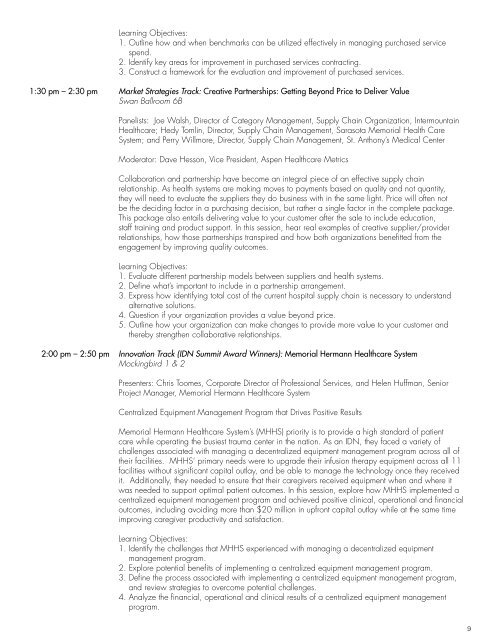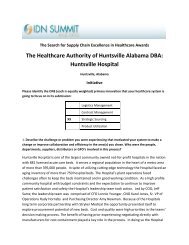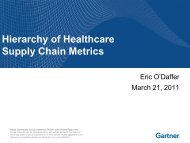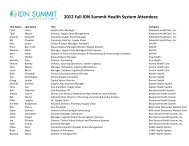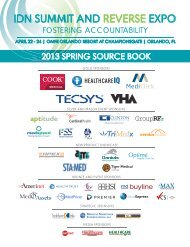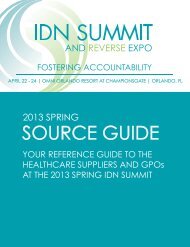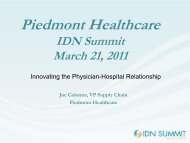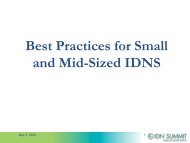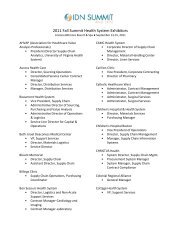PRE-SHOW GUIDE - IDN Summit and Expo
PRE-SHOW GUIDE - IDN Summit and Expo
PRE-SHOW GUIDE - IDN Summit and Expo
You also want an ePaper? Increase the reach of your titles
YUMPU automatically turns print PDFs into web optimized ePapers that Google loves.
Learning Objectives:<br />
1. Outline how <strong>and</strong> when benchmarks can be utilized effectively in managing purchased service<br />
spend.<br />
2. Identify key areas for improvement in purchased services contracting.<br />
3. Construct a framework for the evaluation <strong>and</strong> improvement of purchased services.<br />
1:30 pm – 2:30 pm Market Strategies Track: Creative Partnerships: Getting Beyond Price to Deliver Value<br />
Swan Ballroom 6B<br />
<br />
Panelists: Joe Walsh, Director of Category Management, Supply Chain Organization, Intermountain<br />
Healthcare; Hedy Tomlin, Director, Supply Chain Management, Sarasota Memorial Health Care<br />
System; <strong>and</strong> Perry Willmore, Director, Supply Chain Management, St. Anthony’s Medical Center<br />
Moderator: Dave Hesson, Vice President, Aspen Healthcare Metrics<br />
Collaboration <strong>and</strong> partnership have become an integral piece of an effective supply chain<br />
relationship. As health systems are making moves to payments based on quality <strong>and</strong> not quantity,<br />
they will need to evaluate the suppliers they do business with in the same light. Price will often not<br />
be the deciding factor in a purchasing decision, but rather a single factor in the complete package.<br />
This package also entails delivering value to your customer after the sale to include education,<br />
staff training <strong>and</strong> product support. In this session, hear real examples of creative supplier/provider<br />
relationships, how those partnerships transpired <strong>and</strong> how both organizations benefitted from the<br />
engagement by improving quality outcomes.<br />
Learning Objectives:<br />
1. Evaluate different partnership models between suppliers <strong>and</strong> health systems.<br />
2. Define what’s important to include in a partnership arrangement.<br />
3. Express how identifying total cost of the current hospital supply chain is necessary to underst<strong>and</strong><br />
alternative solutions.<br />
4. Question if your organization provides a value beyond price.<br />
5. Outline how your organization can make changes to provide more value to your customer <strong>and</strong><br />
thereby strengthen collaborative relationships.<br />
2:00 pm – 2:50 pm Innovation Track (<strong>IDN</strong> <strong>Summit</strong> Award Winners): Memorial Hermann Healthcare System<br />
Mockingbird 1 & 2<br />
Presenters: Chris Toomes, Corporate Director of Professional Services, <strong>and</strong> Helen Huffman, Senior<br />
Project Manager, Memorial Hermann Healthcare System<br />
Centralized Equipment Management Program that Drives Positive Results<br />
Memorial Hermann Healthcare System’s (MHHS) priority is to provide a high st<strong>and</strong>ard of patient<br />
care while operating the busiest trauma center in the nation. As an <strong>IDN</strong>, they faced a variety of<br />
challenges associated with managing a decentralized equipment management program across all of<br />
their facilities. MHHS’ primary needs were to upgrade their infusion therapy equipment across all 11<br />
facilities without significant capital outlay, <strong>and</strong> be able to manage the technology once they received<br />
it. Additionally, they needed to ensure that their caregivers received equipment when <strong>and</strong> where it<br />
was needed to support optimal patient outcomes. In this session, explore how MHHS implemented a<br />
centralized equipment management program <strong>and</strong> achieved positive clinical, operational <strong>and</strong> financial<br />
outcomes, including avoiding more than $20 million in upfront capital outlay while at the same time<br />
improving caregiver productivity <strong>and</strong> satisfaction.<br />
Learning Objectives:<br />
1. Identify the challenges that MHHS experienced with managing a decentralized equipment<br />
management program.<br />
2. Explore potential benefits of implementing a centralized equipment management program.<br />
3. Define the process associated with implementing a centralized equipment management program,<br />
<strong>and</strong> review strategies to overcome potential challenges.<br />
4. Analyze the financial, operational <strong>and</strong> clinical results of a centralized equipment management<br />
program.<br />
9


